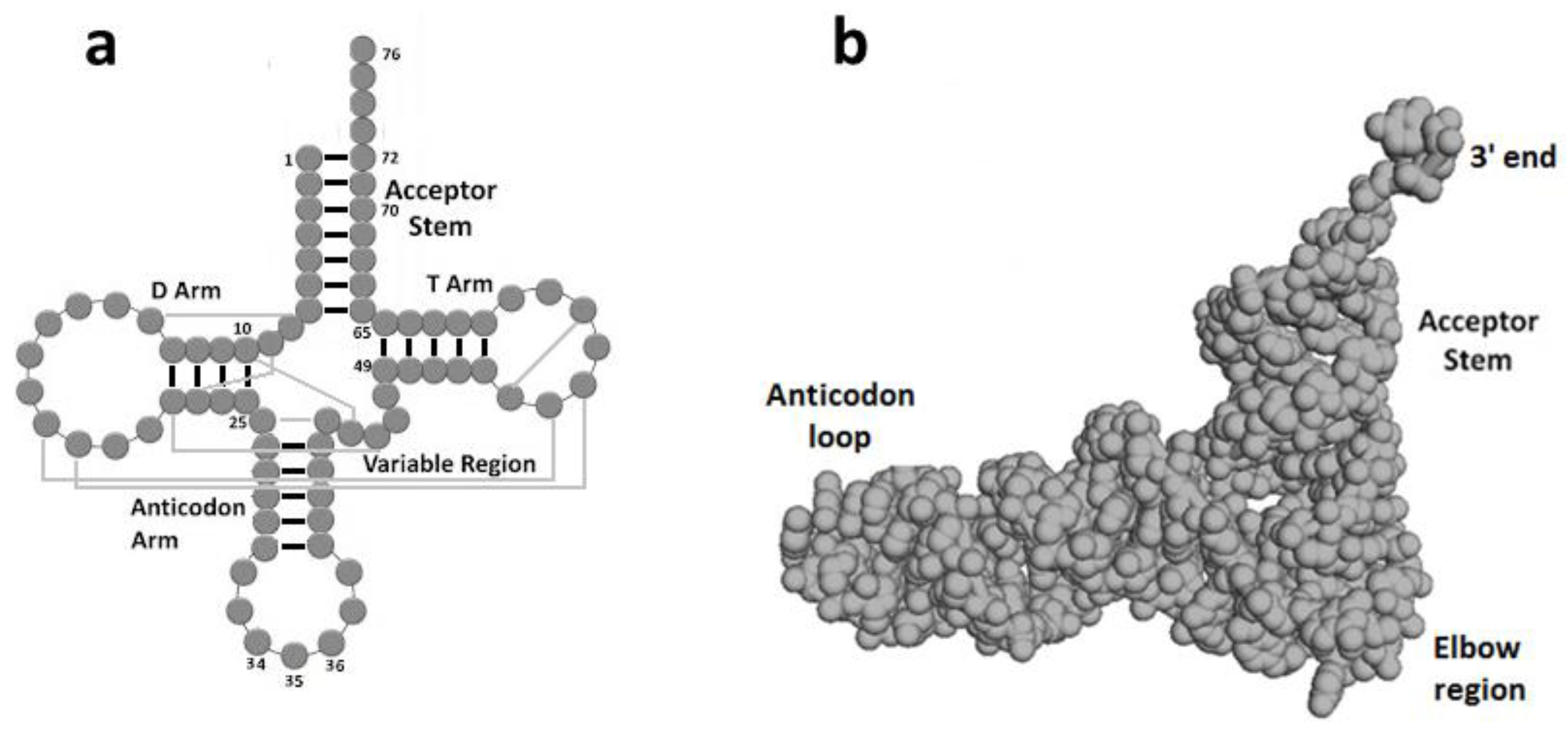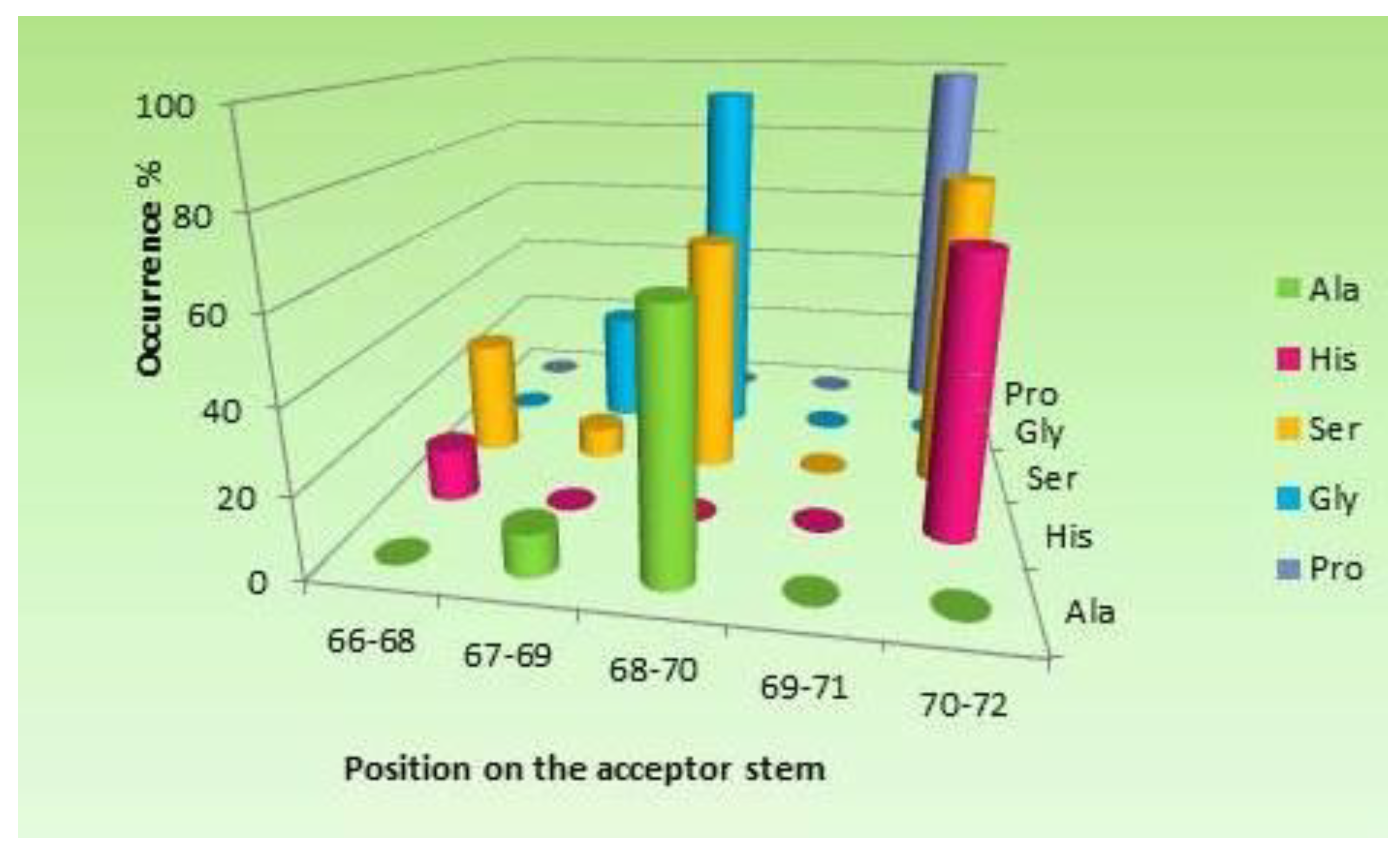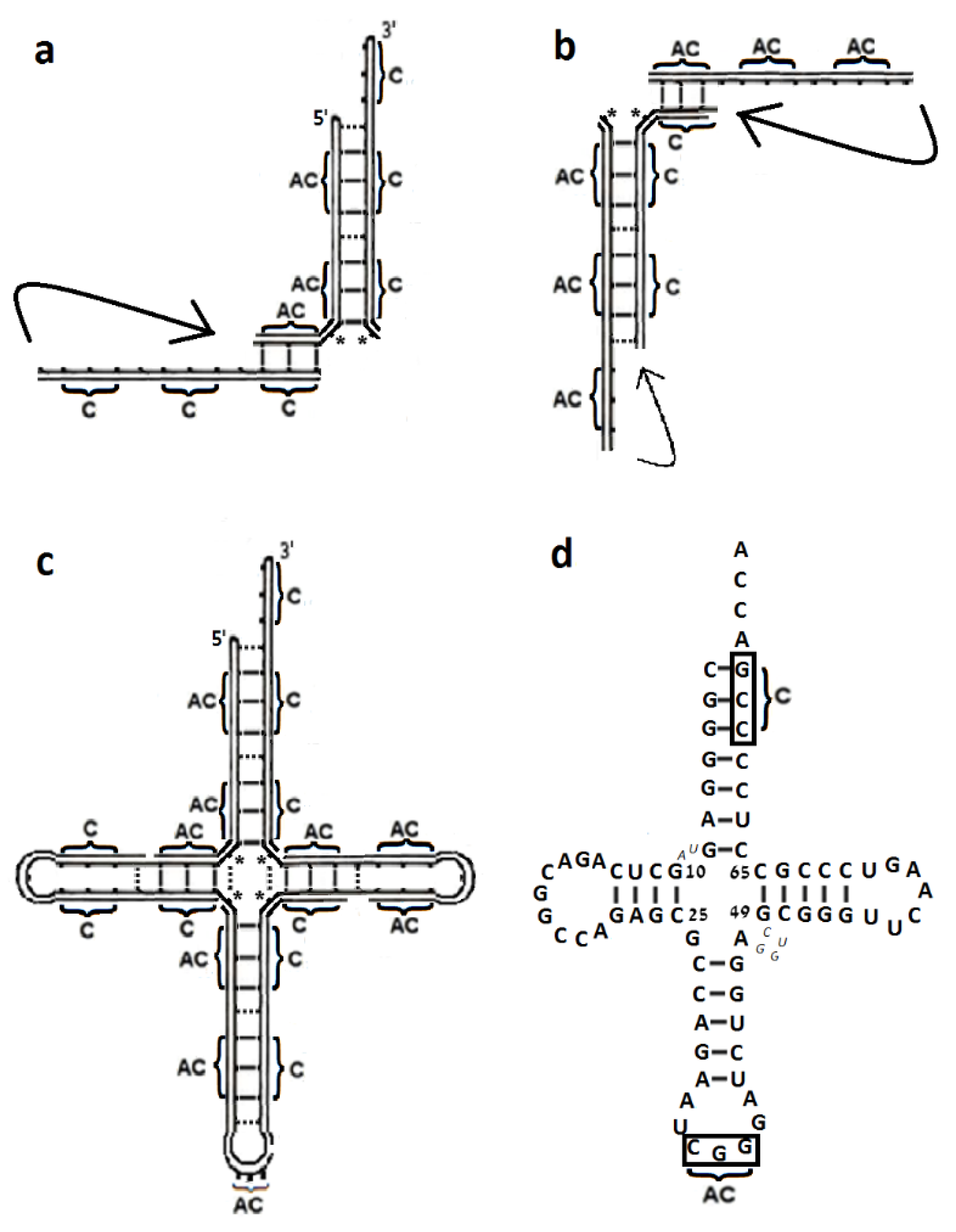Prebiotic Assembly of Cloverleaf tRNA, Its Aminoacylation and the Origin of Coding, Inferred from Acceptor Stem Coding-Triplets
Abstract
1. Introduction
2. Results
2.1. Shape of the Proto-tRNA
2.2. Initial Coding and Specific Aminoacylation of Proto-tRNAs
2.3. Autonomous Formation of Proto-tRNAs
2.3.1. Formation of a 3-Arm Proto-tRNA
2.3.2. Formation of the 4-Arm Proto-tRNA
2.3.3. The 4-Arm Model vs. Coding-Triplets Conservation in the Modern Acceptor Stems
3. Discussion
3.1. Self-Aminoacylation and the Fundamental Code
3.2. Models for the Spontaneous Formation of Cloverleaf tRNA
- (a)
- The models require an initial RNA strand with an array of three coding triplets that can be found in more than 0.02% of the 12-mer oligonucleotides with random sequences. Adding to that the requirement that the non-specific nucleotides forming the “snap fasteners” should be complementary (Figure 5c,d), results in a statistical probability of (1/4)8, i.e., about 1 in 70,000 random 12-mer oligonucleotides would be suitable for serving as a building block of a cloverleaf proto-tRNA.
- (b)
- Spontaneous replication of 12-mer RNA strands, their unzipping under change in environmental conditions and recombination to form the 3-arm or 4-arm models, are feasible chemical reactions in a prebiotic environment lacking biological catalysts.
- (c)
- Self-assembly of the strands relies on base pairing, a reaction which occurs spontaneously. The few ligation reactions required for forming the loops in the cloverleaf model are facilitated by the proximity of the ligated nucleotides, whose strands are already held together by base pairing.
- (d)
- The 4-arm model preserves the primary and secondary constraints that underlie the three-dimensional folding of the tRNA structure; it naturally yields a 3′ end tail of four nucleotides, allows tertiary base pairing between the D–T loops, and guarantees the existence of coding triplets at the beginning of the acceptor stem and in the anticodon loop.
- (e)
- (f)
- The formation of cloverleaf tRNA structure from 12-mer oligonucleotides can be experimentally examined. Placing in a test tube, under various environmental conditions, 12-mer RNA strands, each carrying an array of three codons or of the complementary three AC triplets, with appropriate “snap fasteners” nucleotides, is suggested here to enable the spontaneous formation of some tRNA molecules with a cloverleaf secondary structure.
3.3. Was There an RNA World?
Supplementary Materials
Funding
Data Availability Statement
Acknowledgments
Conflicts of Interest
References
- Schulman, L.H.; Pelka, H. Anticodon switching changes the identity of methionine and valine transfer RNAs. Science 1988, 242, 765–768. [Google Scholar] [CrossRef] [PubMed]
- Giegé, R.; Sissler, M.; Florentz, C. Universal rules and idiosyncratic features in tRNA identity. Nucleic Acids Res. 1998, 26, 5017–5035. [Google Scholar] [CrossRef] [PubMed]
- Normanly, J.; Abelson, J. tRNA identity. Annu. Rev. Biochem. 1989, 58, 1029–1049. [Google Scholar] [CrossRef] [PubMed]
- Schimmel, P.; Giegé, R.; Moras, D.; Yokoyama, S. An operational RNA code for amino acids and possible relationship to genetic code. Proc. Natl. Acad. Sci. USA 1993, 90, 8763–8768. [Google Scholar] [CrossRef]
- Sampson, J.R.; Saks, M.E. Contributions of discrete tRNA(Ser) domains to aminoacylation by E. coIi seryl-tRNA synthetase: A kinetic analysis using model RNA substrates. Nucleic Acids Res. 1993, 21, 4467–4475. [Google Scholar] [CrossRef]
- Möller, W.; Janssen, G.M. Statistical evidence for remnants of the primordial code in the acceptor stem of prokaryotic transfer RNA. J. Mol. Evol. 1992, 34, 471–477. [Google Scholar] [CrossRef]
- Rould, M.A.; Perona, J.J.; Söll, D.; Steitz, T.A. Structure of E. coli glutaminyl-tRNA synthetase complexed with tRNAGln and ATP at 2.8 A° resolution. Science 1989, 246, 1135–1142. [Google Scholar] [CrossRef]
- Noller, H.F. On the origin of the ribosome: Coevolution of subdomains of tRNA and rRNA. In The RNA World; Gesteland, R.F., Atkins, J.F., Eds.; Cold Spring Harbor Laboratory Press: New York, NY, USA, 1993; pp. 137–156. [Google Scholar]
- Agmon, I.; Fayerverker, I.; Mor, T. Coding triplets in the tRNA acceptor-TΨC arm and their role in present and past tRNA recognition. FEBS Lett. 2021, 595, 913–924. [Google Scholar] [CrossRef]
- Ribas De Pouplana, L.; Schimmel, P. Two Classes of tRNA Synthetases Suggested by Sterically Compatible Dockings on tRNA Acceptor Stem. Cell 2001, 104, 191–193. [Google Scholar] [CrossRef]
- Kuhn, H.; Waser, J. Evolution of early mechanisms of translation of genetic information into polypeptides. Nature 1982, 298, 585–586. [Google Scholar] [CrossRef]
- Schimmel, P.; Henderson, B. Possible role of aminoacyl-RNA complexes in noncoded peptide synthesis and origin of coded synthesis. Proc. Natl. Acad. Sci. USA 1994, 91, 11283–11286. [Google Scholar] [CrossRef] [PubMed]
- Lehmann, J. Physico-chemical constraints connected with the coding properties of the genetic system. J. Theor. Biol. 2000, 202, 129–144. [Google Scholar] [CrossRef] [PubMed]
- Brosius, J. tRNAs in the spotlight during protein biosynthesis. Trends Biochem. Sci. 2001, 26, 653–656. [Google Scholar] [CrossRef] [PubMed]
- Di Giulio, M. The origin of the tRNA molecule: Implications for the origin of protein synthesis. J. Theor. Biol. 2004, 226, 89–93. [Google Scholar] [CrossRef] [PubMed]
- Agmon, I. Hypothesis: Spontaneous Advent of the Prebiotic Translation System via the Accumulation of L-Shaped RNA Elements. Int. J. Mol. Sci. 2018, 19, 4021. [Google Scholar] [CrossRef]
- Yusupov, M.M.; Yusupova, G.Z.; Baucom, A.; Lieberman, K.; Earnest, T.N.; Cate, J.H.; Noller, H.F. Crystal structure of the ribosome at 5.5 A resolution. Science 2001, 292, 883–896. [Google Scholar] [CrossRef]
- Wolf, Y.I.; Koonin, E.V. On the origin of the translation system and the genetic code in the RNA world by means of natural selection, exaptation, and subfunctionalization. Biol. Direct. 2007, 2, 14. [Google Scholar] [CrossRef]
- Woese, C.R. On the evolution of the genetic code. Proc. Natl. Acad. Sci. USA 1965, 54, 1546–1552. [Google Scholar] [CrossRef]
- Lehmann, J.; Reichel, A.; Buguin, A.; Libchaber, A. Efficiency of a self-aminoacylating ribozyme: Effect of the length and base-composition of its 3′ extension. RNA 2007, 13, 1191–1197. [Google Scholar] [CrossRef][Green Version]
- Krzyzaniak, A.; Barciszewski, J.; Sałanski, P.; Jurczak, J. The non-enzymatic specific amino-acylation of transfer RNA at high pressure. Int. J. Biol. Macromol. 1994, 16, 153–158. [Google Scholar] [CrossRef] [PubMed]
- Corliss, J.B.; Baross, J.A.; Hoffman, S.E. An hypothesis concerning the relationship between submarine hot springs and the origin of life on earth. Oceanol. Acta 1981, 4, 59–69. [Google Scholar]
- Koonin, E.V. Frozen accident pushing 50: Stereochemistry, expansion, and chance in the evolution of the genetic code. Life 2017, 7, E22. [Google Scholar] [CrossRef] [PubMed]
- Hartman, H. Speculations on the evolution of the genetic code IV. The evolution of the aminoacyl-tRNA synthetases. Orig. Life Evol. Biosph. 1995, 25, 265–269. [Google Scholar] [CrossRef]
- Saks, M.E.; Sampson, J.R. Variant minihelix RNAs reveal sequence-specific recognition of the helical tRNA(Ser) acceptor stem by E. coli seryl-tRNA synthetase. EMBO J. 1996, 15, 2843–2849. [Google Scholar] [CrossRef]
- Cusack, S.; Yaremchuk, A.; Tukalo, M. The crystal structure of the ternary complex of T. thermophilus seryl-tRNA synthetase with tRNA(Ser) and a seryl-adenylate analogue reveals a conformational switch in the active site. EMBO J. 1996, 15, 2834–2842. [Google Scholar] [CrossRef] [PubMed]
- Jühling, F.; Mörl, M.; Hartmann, R.K.; Sprinzl, M.; Stadler, P.F.; Pütz, J. tRNAdb 2009: Compilation of tRNA sequences and tRNA genes. Nucleic Acids Res. 2009, 37, D159–D162. [Google Scholar] [CrossRef] [PubMed]
- Salditt, A.; Keil, L.M.R.; Horning, D.P.; Mast, C.B.; Joyce, G.F.; Braun, D. Thermal Habitat for RNA Amplification and Accumulation. Phys. Rev. Lett. 2020, 125, 048104. [Google Scholar] [CrossRef] [PubMed]
- Powner, M.W.; Gerland, B.; Sutherland, J.D. Synthesis of Activated Pyrimidine Ribonucleotides in Prebiotically Plausible Conditions. Nature 2009, 459, 239–242. [Google Scholar] [CrossRef]
- Powner, M.W.; Sutherland, J.D.; Szostak, J.W. Chemoselective Multicomponent One-Pot Assembly of Purine Precursors in Water. J. Am. Chem. Soc. 2010, 132, 16677–16688. [Google Scholar] [CrossRef]
- Miller, S.L.; Urey, H.C.; Oró, J. Origin of organic compounds on the primitive earth and in meteorites. J. Mol. Evol. 1976, 9, 59–72. [Google Scholar] [CrossRef]
- Ferris, J.P.; Hill, A.R., Jr.; Liu, R.; Orgel, L.E. Synthesis of long prebiotic oligomers on mineral surfaces. Nature 1996, 381, 59–61. [Google Scholar] [CrossRef] [PubMed]
- Mast, C.B.; Schink, S.; Gerland, U.; Braun, D. Escalation of polymerization in a thermal gradient. Proc. Natl. Acad. Sci. USA 2013, 110, 8030–8035. [Google Scholar] [CrossRef] [PubMed]
- Inoue, T.; Orgel, L.E. Oligomerization of (guanosine 5′-phosphor)-2-methylimidazolide on poly(C). An RNA polymerase model. J. Mol. Biol. 1982, 162, 201–217. [Google Scholar] [CrossRef] [PubMed]
- Agmon, I.; Bashan, A.; Zarivach, R.; Yonath, A. Symmetry at the active site of the ribosome: Structural and functional implications. Biol. Chem. 2005, 386, 833–844. [Google Scholar] [CrossRef] [PubMed]
- Agmon, I.; Davidovich, C.; Bashan, A.; Yonath, A. Identification of the Prebiotic Translation Apparatus within the Contemporary Ribosome. Available online: http://precedings.nature.com/documents/2921/version/1 (accessed on 18 March 2009).
- Agmon, I. The dimeric proto-ribosome: Structural details and implications on the origin of life. Int. J. Mol. Sci. 2009, 10, 2921–2934. [Google Scholar] [CrossRef]
- Xu, D.; Wang, Y. Protein-free ribosomal RNA scaffolds can assemble poly-lysine oligos from charged tRNA fragments. Biochem. Biophys. Res. Commun. 2021, 544, 81–85. [Google Scholar] [CrossRef]
- Bose, T.; Fridkin, G.; Davidovich, C.; Krupkin, M.; Dinger, N.; Falkovich, A.; Peleg, Y.; Agmon, I.; Bashan, A.; Yonath, A. Origin of life: Protoribosome forms peptide bonds and links RNA and protein dominated worlds. Nucleic Acid Res. 2022, 50, 1815–1828. [Google Scholar] [CrossRef]
- Yarus, M.; Caporaso, J.G.; Knight, R. Origins of the genetic code: The Escaped Triplet Theory. Annu. Rev. Biochem. 2005, 74, 179–198. [Google Scholar] [CrossRef]
- Johnson, D.B.; Wang, L. Imprints of the genetic code in the ribosome. Proc. Natl. Acad. Sci. USA 2010, 107, 8298–8303. [Google Scholar] [CrossRef]
- Woese, C.R. The Genetic Code; Harper and Row: New York, NY, USA, 1967. [Google Scholar]
- Rodin, S.N.; Ohno, S. Four primordial modes of tRNA-synthetase recognition, determined by the (G,C) operational code. Proc. Natl. Acad. Sci. USA 1997, 94, 5183–5188. [Google Scholar] [CrossRef]
- de Duve, C. Transfer RNAs: The second genetic code. Nature 1988, 333, 117–118. [Google Scholar] [CrossRef] [PubMed]
- Crick, F.H.C. The origin of the genetic code. J. Mol. Biol. 1968, 38, 367–379. [Google Scholar] [CrossRef]
- Eigen, M.; Winkler-Oswatitsch, R. Transfer-RNA, an early gene? Naturwissenschaften 1981, 68, 282–292. [Google Scholar] [CrossRef] [PubMed]
- Bloch, D.P.; McArthur, B.; Mirrop, S. tRNA-rRNA sequence homologies: Evidence from an ancient modular format shared by tRNAs and rRNAs. BioSystems 1985, 17, 209–225. [Google Scholar] [CrossRef] [PubMed]
- Schimmel, P.; Ribas de Pouplana, L. Transfer RNA: From minihelix to genetic code. Cell 1995, 81, 983–986. [Google Scholar] [CrossRef]
- Di Giulio, M. On the origin of the transfer RNA molecule. J. Theor. Biol. 1992, 159, 199–214. [Google Scholar] [CrossRef]
- Dick, T.P.; Schamel, W.A. Molecular evolution of transfer RNA from two precursor hairpins: Implications for the origin of protein synthesis. J. Mol. Evol. 1995, 1, 1–9. [Google Scholar] [CrossRef]
- Nagaswamy, U.; Fox, G.E. RNA ligation and the origin of tRNA. Orig. Life Evol. Biosph. 2003, 33, 199–209. [Google Scholar] [CrossRef]
- Widmann, J.; Di Giulio, M.; Yarus, M.; Knight, R. tRNA Creation by hairpin duplication. J. Mol. Evol. 2005, 61, 524–530. [Google Scholar] [CrossRef]
- Sun, F.J.; Caetano-Anolles, G. The origin and evolution of tRNA inferred from phylogenetic analysis of structure. J. Mol. Evol. 2008, 66, 21–35. [Google Scholar] [CrossRef]
- Rodin, A.S.; Szathmáry, E.; Rodin, S.N. On origin of genetic code and tRNA before translation. Biol. Direct 2011, 6, 14. [Google Scholar] [CrossRef] [PubMed]
- Maizels, N.; Weiner, A.M. Phylogeny from function: Evidence from the molecular fossil record that tRNA originated in replication, not translation. Proc. Natl. Acad. Sci. USA 1994, 91, 6729–6734. [Google Scholar] [CrossRef]
- Randau, L.; Richard, R.; Hohn, M.J.; Jahn, D.; Söll, D. Nanoarchaeum equitans creates tRNAs functional from separate genes for their 5′-and 3′-halves. Nature 2005, 433, 537–541. [Google Scholar] [CrossRef] [PubMed]
- Gilbert, W. The RNA world. Nature 1986, 319, 618. [Google Scholar] [CrossRef]
- Bowman, J.C.; Hud, N.V.; Williams, L.D. The ribosome challenge to the RNA world. J. Mol. Evol. 2015, 80, 143–161. [Google Scholar] [CrossRef] [PubMed]
- Agmon, I.; Mor, T. A Model for the Emergence of Coded Life. In Theory and Practice of Natural Computing; TPNC 2015. Lecture Notes in Computer Science; Dediu, A.H., Magdalena, L., Martín-Vide, C., Eds.; Springer: Cham, Switzerland, 2015; Volume 9477. [Google Scholar]





Publisher’s Note: MDPI stays neutral with regard to jurisdictional claims in published maps and institutional affiliations. |
© 2022 by the author. Licensee MDPI, Basel, Switzerland. This article is an open access article distributed under the terms and conditions of the Creative Commons Attribution (CC BY) license (https://creativecommons.org/licenses/by/4.0/).
Share and Cite
Agmon, I. Prebiotic Assembly of Cloverleaf tRNA, Its Aminoacylation and the Origin of Coding, Inferred from Acceptor Stem Coding-Triplets. Int. J. Mol. Sci. 2022, 23, 15756. https://doi.org/10.3390/ijms232415756
Agmon I. Prebiotic Assembly of Cloverleaf tRNA, Its Aminoacylation and the Origin of Coding, Inferred from Acceptor Stem Coding-Triplets. International Journal of Molecular Sciences. 2022; 23(24):15756. https://doi.org/10.3390/ijms232415756
Chicago/Turabian StyleAgmon, Ilana. 2022. "Prebiotic Assembly of Cloverleaf tRNA, Its Aminoacylation and the Origin of Coding, Inferred from Acceptor Stem Coding-Triplets" International Journal of Molecular Sciences 23, no. 24: 15756. https://doi.org/10.3390/ijms232415756
APA StyleAgmon, I. (2022). Prebiotic Assembly of Cloverleaf tRNA, Its Aminoacylation and the Origin of Coding, Inferred from Acceptor Stem Coding-Triplets. International Journal of Molecular Sciences, 23(24), 15756. https://doi.org/10.3390/ijms232415756




